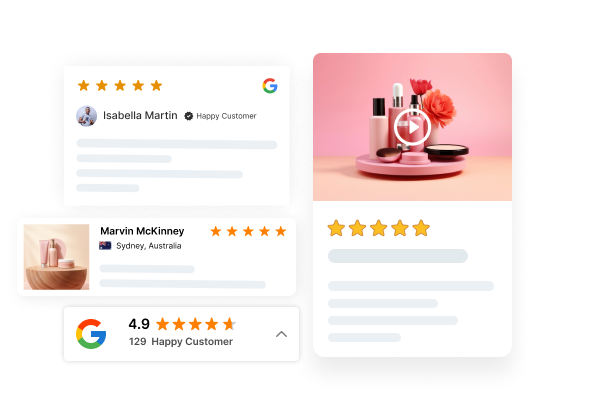Social proof drives decisions in every industry, stars and photo reviews in retail, case studies and badges in SaaS, fresh Google reviews for local services, and real guest photos with quick replies in travel.
Buyers want clear ratings, recent reviews, genuine photos, verified testimonials, and fast human responses.
This report contains 58 social proof statistics on what buyers expect, which signals work best, and where to place proof to increase clicks, sign-ups, and sales.
Top highlight
- 71% of people said they wouldn’t even consider using a business with fewer than three stars.
- Quick replies count – 73% would switch to a competitor if a brand ignores them on social media.
- Influencers impact buying – 49% of people buy something at least once a month because of an influencer’s post.
- People buy from those they follow – 77% are more likely to purchase from brands they follow online.
- Even business leaders check social media – 84% of executives review a company’s social presence before deciding to work with them.
- All age groups expect around 112 reviews on average.
- 92% of consumers feel hesitant to buy when there are no customer reviews available.
- 88% of Gen Z and Millennials say authenticity is important when following influencers.
- 79% of people have watched a video testimonial to learn about a product, and these videos drive 80% higher conversion uplift than text reviews.
- 75% of marketers believe that user-generated content makes their marketing more engaging.
Key statistics
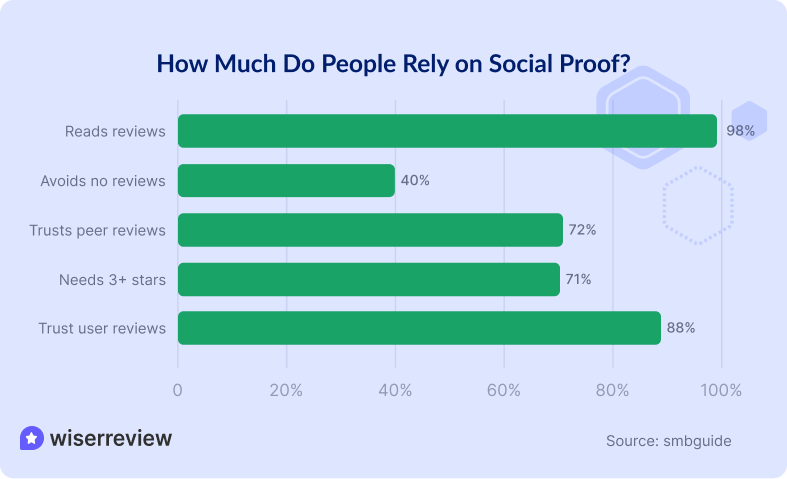
The numbers tell a clear story about how much people rely on social proof:
1. 98% of people read online reviews at least sometimes, while only 2% say they never read them
2. Shoppers read an average of 10 reviews before feeling ready to buy something
3. 72% of consumers trust customer reviews more than a brand’s own product description
4. 40% of consumers avoid buying products that have no reviews at all
5. 71% of customers won’t even consider businesses rated below three stars
These statistics demonstrate that social proof isn’t just desirable, but essential for business success.
Overall consumer behavior & trust
People’s shopping habits have undergone significant changes. They now expect to see proof that others have had positive experiences before they make a purchase.
Trust in Different Sources
When it comes to who consumers trust most, personal connections still win. But social proof from strangers online comes surprisingly close:
6. 92% trust recommendations from friends and family
7. 88% trust user reviews as much as personal recommendations
8. 70% trust online consumer opinions
9. 92% of consumers feel hesitant to buy when there are no customer reviews available.
Shopping Research Patterns
Modern shoppers do their homework. They don’t just buy on impulse anymore:
10. 75% of consumers search for reviews or testimonials before buying
11. The average consumer reads 10 reviews before making a purchase decision
12. 82% of shoppers use their phones to read online reviews while in physical stores
13. 81% of consumers use Google reviews to evaluate local businesses
Age Differences in Expectations
Younger shoppers expect even more social proof:
14. Shoppers aged 18-24 expect an average of 203 reviews per product.
15. All age groups expect around 112 reviews on average.
16. 91% of 18-34 year-olds trust online reviews as much as personal recommendations.
All your reviews in one place
Collect reviews, manage every response, and display them where they matter most.Impact of reviews & ratings
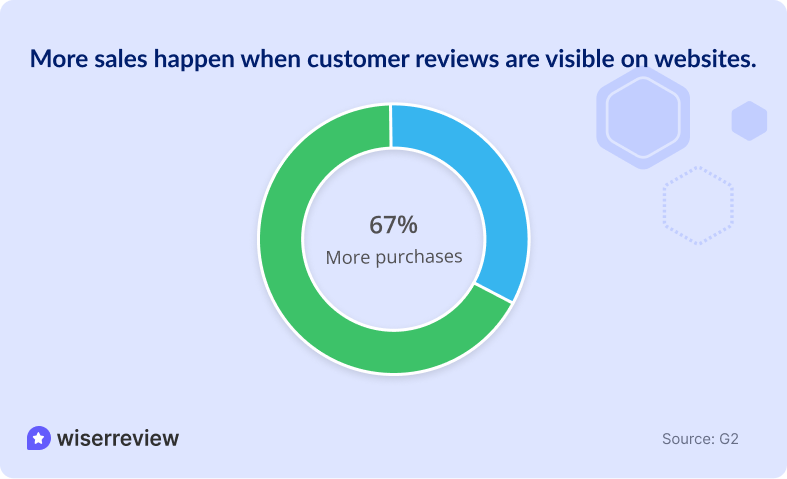
Reviews and star ratings have a significant impact on influencing buying decisions. The data shows just how much they matter.
Conversion Impact
Good reviews don’t just build trust – they directly increase sales:
17. Displaying reviews can increase conversions by up to 270% when five or more reviews are present.
18. 67% more purchases happen when customer reviews are visible on websites.
19. Products with positive ratings see a 68% higher likelihood of being chosen by consumers
Star Rating Standards
Customer expectations for star ratings keep getting higher:
20. 71% of customers won’t consider businesses rated below three stars (up from previous years).
21. A 3.5-star rating is increasingly viewed as inadequate, as 6% fewer consumers were willing to use businesses with a 3.5-star rating in 2024 compared to 2023.
22. Positive ratings increase the likelihood of choosing a local business by 68%.
Review Freshness Matters
People don’t just want reviews – they want recent ones:
23. 58% say the freshness of reviews affects their purchase decisions
Many people want to see activity in the last 30 days. If they don’t, they may assume the brand is inactive or hiding issues.
Businesses need to generate new reviews to maintain trust consistently
Business Response Impact
How businesses handle reviews makes a huge difference:
24. 88% of consumers are more likely to choose businesses that respond to all reviews.
25. 73% of social media users will buy from a competitor if a brand doesn’t respond to customer feedback.
Fast responses matter – businesses that engage quickly see better results
Role of user-generated content & authenticity
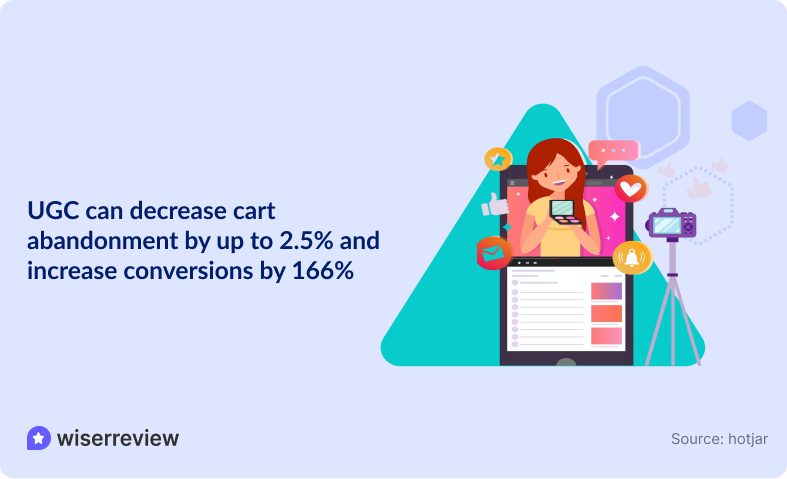
User-generated content (UGC) has become incredibly powerful because it feels more authentic than traditional marketing.
UGC Performance
Real content from real customers outperforms brand-created content:
26. 75% of marketers believe that user-generated content makes their marketing more engaging.
27. UGC can decrease cart abandonment by up to 2.5% and increase conversions by 166%
28. 66% trust product reviews more when they include photos or videos
Authenticity Preferences
People can spot fake content, and they prefer the real thing:
29. 63% of consumers say testimonials featuring real customers are more credible than anonymous quotes
Visual testimonials (photos and videos) are considered more trustworthy than text alone
Customer-submitted photos and videos feel more genuine than polished brand content
Format Impact
Different types of UGC work better for different purposes:
30. Video testimonials provide 80% higher conversion uplift than text reviews
Photos alongside reviews increase trust significantly
Real customer stories create emotional connections that drive purchases
Influencer & expert endorsements
Influencer marketing remains a significant driver of purchasing decisions, particularly among younger consumers.
Purchase Influence
Influencers have a real impact on buying behavior:
31. 49% of consumers make purchases at least monthly due to influencer posts
32. 71% of consumers trust influencer content to some degree
33. 37% trust social media influencers more than brands themselves
Generational Differences
Age plays a significant role in how much people trust influencers:
34. Millennials and Gen Z are twice as likely as Boomers to trust influencer advice
35. 72% of Gen Z and Millennials follow at least some social media influencers
36. 87% of Gen Z are more willing to buy from brands that work with influencers
Authenticity Over Fame
Smaller, more authentic influencers often work better than celebrities:
37. 88% of Gen Z and Millennials say authenticity is important when following influencers
38. Only 29% care about the number of followers an influencer has
39. Nano-influencers (1K-5K followers) see engagement rates over 5%, which is 3x higher than mega-influencers
Industry Applications
Different industries use influencer marketing differently:
40. 81% of Gen Z travelers and 75% of Millennials consider social media content when choosing destinations
41. B2B buyers prefer expert opinions and peer reviews over traditional social media influencers
42. Local businesses benefit more from community figures and micro-influencers than celebrities
Social proof & conversion
The connection between social proof and higher conversion rates is apparent across all types of businesses.
Conversion Rate Improvements
Different types of social proof deliver different levels of improvement:
43. Real-time social proof notifications boost conversions by 98% compared to static pages
44. Adding just three customer testimonials can increase conversion rates by 34%
45. B2B SaaS companies see conversion improvements ranging from 10% to 270%
Implementation Impact
Where and how you show social proof matters:
- Social proof is most effective when placed near decision points, such as checkout buttons.
- Multiple types of social proof work better than just one type
- The quality of social proof matters more than quantity
Industry Variations
Different industries see different levels of impact:
- E-commerce sites with reviews see significantly higher conversion rates
- SaaS companies benefit most from case studies and detailed testimonials
- Local service businesses need a strong Google review presence
Trust signals & other indicators
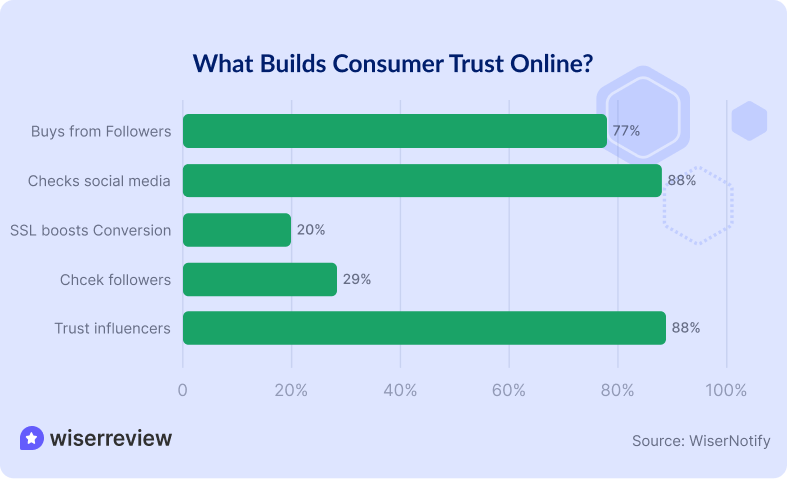
Beyond reviews and testimonials, other trust signals play essential roles in building confidence.
Security and Safety Signals
Online safety concerns drive the need for visible trust indicators:
46. Websites with SSL certificates see 15-20% higher conversion rates.
47. 18% of cart abandonment happens because customers don’t trust websites with their credit card information
Payment provider logos (Visa, Mastercard, PayPal) increase checkout completion
Third-Party Validations
External endorsements carry significant weight:
48. 18% of cart abandonment happens because customers don’t trust websites with their credit card information
Professional accreditations matter especially in regulated industries
Social Media Metrics
Follower counts and engagement levels serve as crowd-based proof:
49. 77% of consumers are more likely to buy from brands they follow on social media
50. 84% of executives check a company’s social media before making B2B purchases
51. High engagement levels signal that others find the brand valuable
All your reviews in one place
Collect reviews, manage every response, and display them where they matter most.
Implications & trends for the future
Social proof is getting smarter, more visual, and more transparent. People expect authentic voices, fast signals, and clear proof they can trust. Use the shifts below to guide your roadmap.
AI and Automation
Technology is changing how businesses collect and use social proof:
- AI tools help identify the best customer testimonials to feature
- Automated review request systems ensure consistent collection
- Real-time social proof notifications boost conversions by 10–15% by showing live customer actions.
Video and Visual Content
Visual social proof is becoming more important:
- 79% of people have watched a video testimonial to learn about a product, and these videos drive 80% higher conversion uplift than text reviews.
- User-generated photos and videos carry more weight than text
- Live streaming and real-time content create immediate social proof
Privacy and Authenticity
Consumers are getting better at spotting fake social proof:
- 85% of consumers say they read verified reviews often or very often before buying, and they trust verified reviews more than unverified ones.
- Privacy concerns affect how businesses can collect and display customer information
- Transparency about review collection methods builds trust
Platform Evolution
New social media platforms and features create new opportunities:
- Emerging platforms offer fresh ways to showcase social proof
- Platforms like Instagram Checkout and TikTok Shop are expected to drive $85.6 billion in U.S. social commerce sales by 2025.
- Community-based platforms emphasize peer recommendations.
How businesses leverage social proof
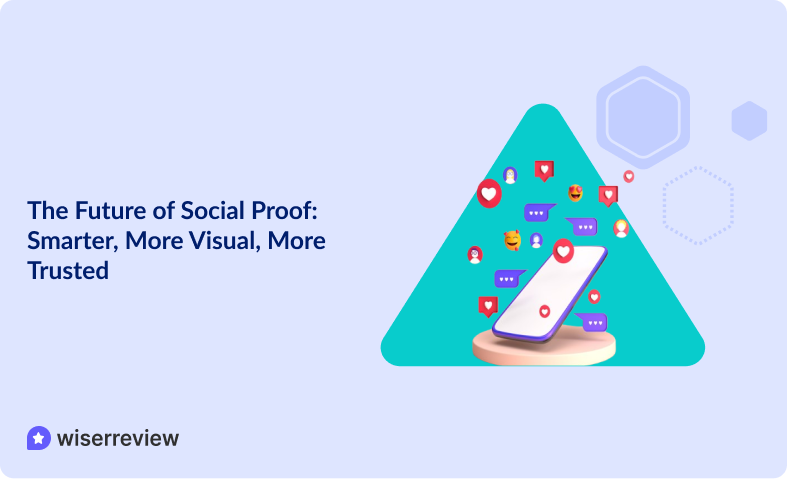
Innovative companies use social proof across all their marketing channels, not just on their websites.
On websites and product pages
The most common place to see social proof is on business websites:
Homepage Elements
- Customer logos and testimonials build immediate credibility.
- User count displays show popularity (“Join 50,000+ happy customers”).
- Media mentions and awards create third-party validation.
Product Page Optimization
- Star ratings and review counts appear prominently near product titles.
- Customer photos and videos show real usage.
- “Best seller” and “customer favorite” badges highlight popular items.
Checkout Process
- Security badges and payment logos reduce purchase anxiety.
- Money-back guarantees are prominently displayed.
- Recent purchase notifications create urgency (“5 people bought this in the last hour”).
On social media
Social platforms offer unique opportunities for social proof:
Engagement as Proof
- High like, share, and comment counts signal content quality
- User-generated content reshares show authentic customer experiences
- Responsive customer service demonstrates care and attention
Community Building
- Active follower engagement creates a sense of community.
- User challenges and hashtag campaigns generate authentic content.
- Live interactions show real-time brand responsiveness.
Platform-Specific Strategies
- Instagram stories highlight customer experiences.
- LinkedIn showcases client success stories and industry recognition.
- TikTok leverages user-generated videos for authentic product demonstrations.
Email, ads & offline channels
Social proof works beyond websites and social media:
Email Marketing Integration
- Customer testimonials in promotional emails increase click-through rates.
- Review roundups keep subscribers engaged.
- Media mentions and awards shared via email build credibility.
Advertising Enhancement
- Ads featuring customer reviews see 4x higher click-through rates.
- Star ratings in search ads improve ad performance.
- Customer quotes in display ads build instant credibility.
Offline Applications
- Customer testimonials in physical store displays
- Awards and certifications are prominently displayed in business locations
- Case studies and success stories in sales presentations
Trust-building practices
The most successful businesses adhere to specific practices to establish and maintain trust through social proof.
Consistent Collection
Businesses need systematic approaches to gathering social proof:
- Follow-up emails after purchases, requesting reviews
- Social media monitoring for mentions and user-generated content
- Regular customer interviews for detailed testimonials
Quality Over Quantity
Not all social proof is equally compelling:
- Detailed, specific reviews work better than generic praise
- Video testimonials outperform text-only versions
- Recent reviews matter more than old ones
Strategic Placement
Where social proof appears affects its impact:
- Near decision points like “Buy Now” buttons
- Above the fold on important pages
- Throughout the customer journey, not just at the end
Response and Engagement
How businesses handle social proof affects their credibility:
- Responding to both positive and negative reviews
- Sharing and amplifying user-generated content
- Being transparent about both successes and challenges
All your reviews in one place
Collect reviews, manage every response, and display them where they matter most.Wrap up
Today’s buyers want real proof before they make a decision. They trust other people’s experiences more than brand promises. Reviews, star ratings, customer photos, and fast responses all help build that trust. It’s not enough to say your product is excellent; you need to show it.
Share fresh, honest reviews, real customer stories, and visual proof where it matters most on product pages, social media, emails, and at checkout. When people see others trusting and loving your brand, they’re far more likely to buy.
In short, people trust people, not just marketing, and that’s why social proof is essential.
Frequently asked questions
Signals that people trust you: ratings, reviews, customer photos/videos, testimonials, case studies, and creator or expert mentions.
Get a steady flow and keep them recent. Aim for at least 50+ over time, then keep adding.
Maintain a 4-star Rating, as 3-star ratings often deter most buyers.
They serve different roles. Influencers drive discovery; reviews close the deal. Use both.
Near decisions: product pages, pricing/sign-up, cart/checkout, and your Google profile. Use stars, a few short quotes, and links to full case studies.

 5 min
5 min 
